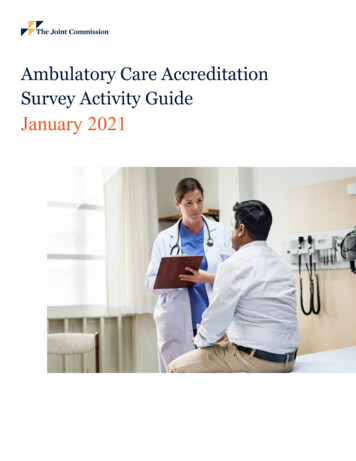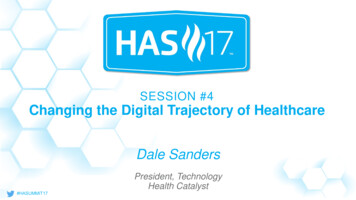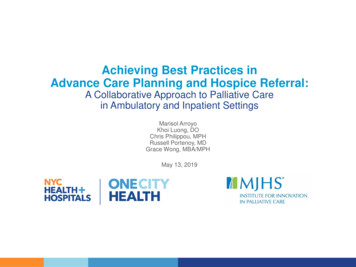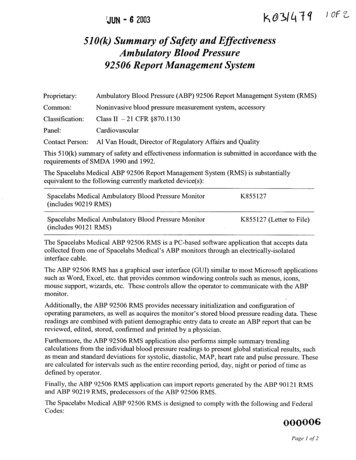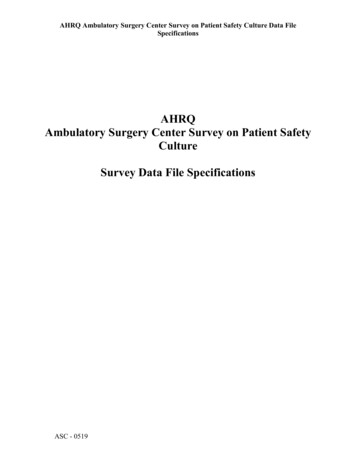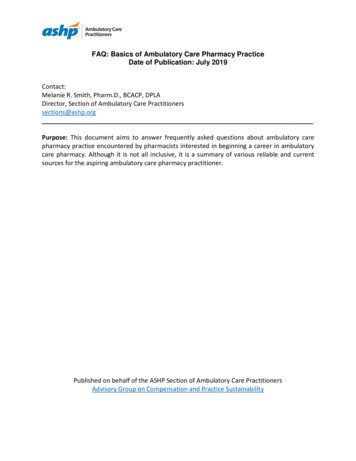
Transcription
FAQ: Basics of Ambulatory Care Pharmacy PracticeDate of Publication: July 2019Contact:Melanie R. Smith, Pharm.D., BCACP, DPLADirector, Section of Ambulatory Care Practitionerssections@ashp.orgPurpose: This document aims to answer frequently asked questions about ambulatory carepharmacy practice encountered by pharmacists interested in beginning a career in ambulatorycare pharmacy. Although it is not all inclusive, it is a summary of various reliable and currentsources for the aspiring ambulatory care pharmacy practitioner.Published on behalf of the ASHP Section of Ambulatory Care PractitionersAdvisory Group on Compensation and Practice Sustainability
Table of ContentsI. Definition: . 3A. What is ambulatory care pharmacy practice? .3B. Where do ambulatory care pharmacists work? .3C. What services do ambulatory care pharmacists provide? .4II. Developing Ambulatory Care Pharmacy Services: . 4A. How do I become an ambulatory care pharmacist? .5B. How do I start ambulatory care pharmacy services? .6C. What is a collaborative practice agreement and how do I create one? .6III. Sustaining Ambulatory Care Pharmacy Services: . 8A. How do I bill for my ambulatory care pharmacy services? .8B. How do I show value for my services? . 10C. How much will I be reimbursed for my ambulatory care services? . 11IV. What are some barriers to expect? . 12V. What is the future of Ambulatory Care Pharmacy? . 13VI. What are some Ambulatory Care Pharmacy Practice Examples? . 14VII. Mentorship: . 16VIII. Contributors and Acknowledgements . 162
I. Definition:A. What is ambulatory care pharmacy practice?In November 2008, the American College of Clinical Pharmacy (ACCP), the American Society ofHealth-System Pharmacists (ASHP), and the American Pharmacists Association (APhA) petitionedthe Board of Pharmacy Specialties (BPS) to recognize ambulatory care pharmacists throughspecialty certification1. In their petition, the ACCP/APhA/ASHP Joint Working Group proposed adefinition for ambulatory care pharmacy practice; that definition is now endorsed by BPS1,2,3.According to the Joint Working Group and BPS, “Ambulatory care pharmacy practice is theprovision of integrated, accessible health care services by pharmacists who are accountable foraddressing medication needs, developing sustained partnerships with patients, and practicing in thecontext of family and community ”1,2,3 It involves being an integral part of an outpatient,multidisciplinary healthcare team to improve quality and patient outcomes by focusing onmedication management.References:1. American College of Pharmacy. A petition to the board of pharmaceutical specialties requesting recognition of ambulatory care pharmacy practice as a tions/BPS Ambulatory Care Petition.pdf. (accessed May 5, 2019.)2. Jannet M. Carmichael, Deanne L. Hall, Evolution of ambulatory care pharmacy practice in the past 50 years, American Journal of Health-System Pharmacy, Volume72, Issue 23, 1 December 2015, Pages 2087–2091, https://doi.org/10.2146/ajhp1506273. Ambulatory care pharmacy. Board of Pharmacy Specialties Web site. are/. (accessed May 5, 2019.)B. Where do ambulatory care pharmacists work?BPS states, “The ambulatory care pharmacists may work in both an institutional and communitybased clinic involved in direct care of a diverse patient population”1.Ambulatory care pharmacists may work in the following settings2,3: Accountable care organizations (ACO) Community based or free clinics Community pharmacies Federally Qualified Health Centers (FQHC) Hospital-based outpatient clinics Indian Health Service Clinics Managed care integrated system Outpatient clinics associated with academic medical centers Patient-Centered Medical Homes (PCMH) Private practice physician clinics Rural Health Clinics Self-insured employee clinics Veterans Affairs (VA) Medical Centers Others3
References:1. Ambulatory care pharmacy. Board of Pharmacy Specialties Web site. are/. (accessed May 5, 2019).2. Skelly, J (2017) Ambulatory Care Basics: Setting the Stage for New Practitioners and Beyond [PowerPoint slides]. Retrieved ioners-and-beyond . (accessed May 5, 2019).3. Weber ZA, Skelley J, Sachdev G, et al. Integration of pharmacists into team-based ambulatory care practice models. Am J Health-Sys Pharm. 2015;72:745-51. doi:10.2146/ajhp140576.C. What services do ambulatory care pharmacists provide?Ambulatory-care pharmacists provide, “.direct patient care and medication management forambulatory patients, long-term relationships, coordination of care, patient advocacy, wellness andhealth promotion, triage and referral, and patient education and self-management”.1Services delivered by ambulatory care pharmacists include, but are not limited to1,2,3,4,5: Access services or care coordination Chronic disease state management Comprehensive medication management Drug information Healthcare provider education Immunization screenings and administration Medication reconciliation Medication Therapy Management (MTM) National Committee for Quality Assurance (NCQA) reporting Ordering, interpreting, and monitoring laboratory tests Participate in transitions of care, annual wellness visits, and group visits Participate in Physician Quality Reporting System (PQRS) Patient education and counseling Preventative care or wellness screenings Prospective or retrospective chart reviews Refill authorization Research & clinical trials Shared visits with other healthcare providers (i.e. physicians, nurses, behavioral healthspecialists)References:1. Ambulatory care pharmacy. Board of Pharmacy Specialties Web site. are/. Accessed May 5, 2019.2. Jannet M. Carmichael, Deanne L. Hall, Evolution of ambulatory care pharmacy practice in the past 50 years, American Journal of Health-System Pharmacy, Volume72, Issue 23, 1 December 2015, Pages 2087–2091, https://doi.org/10.2146/ajhp1506273. Weber ZA, Skelley J, Sachdev G, et al. Integration of pharmacists into team-based ambulatory care practice models. Am J Health-Sys Pharm. 2015;72:745-51.4. Skelly, J (2017) Ambulatory Care Basics: Setting the Stage for New Practitioners and Beyond [PowerPoint slides]. Retrieved ioners-and-beyond5. Recommendations of the summit, American Journal of Health-System Pharmacy, Volume 71, Issue 16, 15 August 2014, Pages 1390–1391,https://doi.org/10.2146/ajhp140299II. Developing Ambulatory Care Pharmacy Services:4
A. How do I become an ambulatory care pharmacist?Although there are no set requirements to become an ambulatory care pharmacist, ASHPconsiders an ASHP-accredited Post Graduate Year One (PGY-1) training as a minimal competency,with a Post Graduate Year Two (PGY-2) training as optimal1. In addition, specialty boardcertification, clinical experience, and continuing-education certification programs should beobtained by all ambulatory care pharmacists involved in direct patient care1. The minimumrequirements to be an ambulatory care pharmacist also vary by state; therefore, check with yourstate board of pharmacy to make sure you are in compliance1,2,3. Healthcare organizations andpayors may also require certain credentials to grant direct patient care privileges2,3. While manycredentialing boards require residency training (i.e. PGY-1 and/or PGY-2) and/or equivalent yearsof experience, and/or board certification (i.e. BCACP), some may request additional credentialsnot unique to pharmacists such as Certified Diabetes Educator (CDE)2.There are various credentials available for ambulatory care pharmacists2,3: Unique to pharmacistso BCACP – Board Certified Ambulatory Care Pharmacisto BCPS – Board Certified Pharmacotherapy Specialisto BCOP – Board Certified Oncology Pharmacisto BCGP – Board Certified Geriatric Pharmacisto BCPP – Board Certified Psychiatric Pharmacist Applicable to pharmacists and other healthcare professionalso BC-ADM – Board Certified – Advanced Diabetes Management4o CDE – Certified Diabetes Educator5o CAE - Certified Asthma Educator6o CTTS - Certified Tobacco Treatment Specialist (CTTS)7o CLS - Clinical Lipid Specialist8oCACP - Certified Anticoagulation Care Provider9For more information, please refer to the document developed by ASHP’s Section of AmbulatoryCare Practitioners titled “Entry-Level Competencies Needed for Ambulatory Care Practice,”10andASHP’s Section Advisory Group on Clinical Practice Advancement document titled “AmbulatoryCare Career Tool”11. If you are interested in pursuing pharmacy residency training, please refer toASHP’s website on residency information12.References:1. American Society of Health-System Pharmacists. ASHP Guidelines: minimum standard for ambulatory care pharmacy practice. Am J Health-Syst Pharm. 2015;72:1221–36.2. Skelly, J (2017) Ambulatory Care Basics: Setting the Stage for New Practitioners and Beyond [PowerPoint slides]. Retrieved ioners-and-beyond3. Weber ZA, Skelley J, Sachdev G, et al. Integration of pharmacists into team-based ambulatory care practice models. Am J Health-Sys Pharm. 2015;72:745-51.4. American Association of Diabetes Educator. Board certified-advanced diabetes management. cation/bc adm.(accessed May 5, 2019).5. National Certification Board for Diabetes Educators. Certified diabetes educator. https://www.ncbde.org/certification info/what-is-a-cde/.(accessed May 5, 2019).6. National Asthma Educator Certification Board. Certified asthma educator. https://naecb.com. (accessed May 5, 2019).7. Council for Tobacco Treatment Training Programs. Accredited programs. https://ctttp.org/accredited-programs/ . (accessed May 5, 2019).8. Accreditation Council for Clinical Lipidology. Clinical lipid specialist. gibility criteria.php . (accessed May 5, 2019).9. National Certification Board for Anticoagulation Providers. How do I get certified? cessed May 5, 2019).5
10. ASHP Section of Ambulatory Care Practitioners. Entry-level competencies needed for ambulatory care practice. el-competencies-2012.ashx. (accessed May 5, 2019).11. ASHP Section Advisory Group on Clinical Practice Advancement. Ambulatory care career tool. e-career-tool.ashx. (accessed May 5, 2019).12.ASHP. Residency information. dency-Information .(accessed May 5, 2019).B. How do I start ambulatory care pharmacy services?There are various factors to consider when starting ambulatory care pharmacy services1,2: Overall factors to considero Be a cooperative team member (identify practice needs and help fill those voids)o Document services and outcomes (specific to your institution; shows value)o Have open communication (share your interventions and outcomes withstakeholders)o Have patience and perseverance (may take months to years)o Identify and collaborate with a physician champion (especially those in leadershippositions at your institution or those who have a positive working experience withambulatory care pharmacists)o Obtaining “buy-in” from stakeholders (clinicians and administrators) Technical factors to consider before patient careo Documentation and data trackingo Fee for service vs value-based reimbursementso Institutional priorities and goalso Payer mix (private vs Medicare vs Medicaid vs commercial insurance)o Space (both office and clinic)o Staff support (scheduling, handling no-shows, etc.)o Workflow (will you share a medical assistant, nurse, or won’t receive help)There are a variety of tools that cover this topic in depth. You are encouraged to visit and readthose sources for more guidance on how to get started3-11.References:1. Skelly, J (2017) Ambulatory Care Basics: Setting the Stage for New Practitioners and Beyond [PowerPoint slides]. Retrieved ioners-and-beyond2. Weber ZA, Skelley J, Sachdev G, et al. Integration of pharmacists into team-based ambulatory care practice models. Am J Health-Sys Pharm. 2015;72:745-51.3. Kliethermes MA, Brown TR, eds. Building a successful ambulatory care practice: A complete guide for pharmacists. Bethesda: ASHP, 2012: 1-298.4. ASHP Practice Advancement Initiative. Resources. http://www.amcareassessment.org/resources.aspx. (accessed May 5, 2019).5. ASHP Practice Advancement Initiative. Ambulatory Care Self-Assessment Tool. http://www.amcareassessment.org/ . (accessed May 5, 2019).6. ASHP Resource Center. Ambulatory Care. nters/Ambulatory-Care . (accessed May 5, 2019).7. Anne Carrington, Ashley Pokallus, Irene Park Ulrich, Mollie Ashe Scott, Allison E. Fay, Evan S. Drake, Courtenay Gilmore Wilson, Essential factors demonstratingreadiness of primary care practices for clinical pharmacy services, American Journal of Health-System Pharmacy, Volume 75, Issue 21, 1 November 2018, Pages 1708–1713, https://doi.org/10.2146/ajhp1801298. Amber Lanae Martirosov, Angela Michael, Melissa McCarty, Opal Bacon, John R. DiLodovico, Arin Jantz, Diana Kostoff, Nancy C. MacDonald, Nancy Mikulandric,Klodiana Neme, Nimisha Sulejmani, Bryant B. Summers, Identifying opportunities to advance practice at a large academic medical center using the ASHP AmbulatoryCare Self-Assessment Tool, American Journal of Health-System Pharmacy, Volume 75, Issue 13, 1 July 2018, Pages 987–992, https://doi.org/10.2146/ajhp1707139. Emily M. Hawes, Caron Misita, Jena Ivey Burkhart, Lauren McKnight, Zachariah M. Deyo, Ruth-Ann Lee, Caroline Howard, Stephen F. Eckel, Prescribing pharmacistsin the ambulatory care setting: Experience at the University of North Carolina Medical Center, American Journal of Health-System Pharmacy, Volume 73, Issue 18, 15September 2016, Pages 1425–1433, https://doi.org/10.2146/ajhp15077110. ASHP. ASHP Guidelines: minimum standard for ambulatory care pharmacy practice. Am J Health-Syst Pharm. 2015; 72:1221–36.11. Castelli G, et al., eds. ACCP Ambulatory Care Pharmacist’s Survival Guide. 4th ed. Lenexa: American College of Clinical Pharmacy; 2019: 1 – 556.C. What is a collaborative practice agreement and how do I create one?6
According to the Centers for Disease Control and Prevention (CDC) and their document AdvancingTeam-Based Care through Collaborative Practice Agreements, a Collaborative Practice Agreement(CPA) is “.a formal agreement in which a licensed provider makes a diagnosis, supervises patientcare, and refers patients to a pharmacist under a protocol that allows the pharmacist to performspecific patient care functions”1,2.Collaborative drug therapy management (CDTM) with physicians and other health care providersvia CPAs allow qualified ambulatory care pharmacists with an advanced scope of practice toinitiate, adjust, and discontinue medications, order and monitor laboratory studies, and performlimited physical assessments3 for various conditions (e.g. diabetes, hypertension, hyperlipidemia,chronic obstructive pulmonary disease, asthma, heart failure, anticoagulation, etc.)1. Theprivileges of ambulatory care pharmacists vary by state, practice site, and payor. For example, insome states they are recognized as Advanced Practice Pharmacist (APP), Clinical PharmacistPractitioner (CPP), or Pharmacist Clinician (PhC)2.The CPA you create must be approved by your collaborating colleague(s), state board of pharmacy,healthcare institution(s), and credentialing body (refer to your state laws for specifics). As youcreate your CPA, be sure to seek advice from all stakeholders, including payors. Once created, theCPA should be reviewed annually or more often (if required by state law). With each review, youshould update the document as needed with input from all stakeholders. For an example of a CPA,please refer to Figure 2: Sample Collaborative Practice Agreement forHypertension/Cardiovascular Disease, pages 15-16 in the “Advancing Team-Based Care ThroughCollaborative Practice Agreements”1. For more on the various types CPAs across the country,please refer to Adams and Weaver’s “The Continuum of Pharmacist Prescriptive Authority”4.References:1. Centers for Disease Control and Prevention. Advancing team-based care through collaborative practice agreements. Care.pdf. (accessed May 5, 2019).2. Skelly, J (2017) Ambulatory Care Basics: Setting the Stage for New Practitioners and Beyond [PowerPoint slides]. Retrieved ioners-and-beyond3. Erin M. Turingan, Jill S. Bates, Lindsey B. Amerine, Integration of physical assessment into pharmacy practice, American Journal of Health-System Pharmacy, Volume75, Issue 4, 15 February 2018, Pages 169–170, https://doi.org/10.2146/ajhp1702744. Adams, Alex J., and Krystalyn K. Weaver. “The Continuum of Pharmacist Prescriptive Authority.” Annals of Pharmacotherapy, vol. 50, no. 9, Sept. 2016, pp. 778–784,7
III. Sustaining Ambulatory Care Pharmacy Services:A. How do I bill for my ambulatory care pharmacy services?Critical questions from stakeholders will deal with billing and compensation for ambulatory carepharmacy services.Process1. Before an initiative is undertaken, you will need to verify the service being proposed issustainable, with a respectable return on investment, and aligns with the mission andvision of your institution1,2. There are various sources available to guide you and thestakeholders through this complicated topic1-9.2. Identify the decision-makers that may impact any portion of the billing process. Keypersonnel in the billing team may include, but not limited to, the clinic manager, clinicscheduler, director of pharmacy, billing department and coding specialist(s), marketing,information technology (IT), chief compliance officer, and others.3. Schedule individual meetings with each of them. Be prepared to present your proposedservices. Ask their perspective and what they believe will be barriers to the proposedinitiatives.4. If you do not already have one, with the help of the credentialing department, apply for anational provider identifier (NPI)10.5. Once you have met with all of them individually, and have a list of their challenges, findevidence-based solutions to those perceived barriers.6. Form a committee and schedule a meeting with all of the billing stakeholders where youwill present them with a summary of your plan, including solutions to their challenges.7. Create an action-plan from the meeting (SMART11 goals or another similar format isrecommended) and schedule recurring meetings to keep the momentum in your favor.8. Once billing is occurring for your services, follow up with stakeholders through committeeand/or individual meetings to assure quality and accuracy.References:1. Weber ZA, Skelley J, Sachdev G, et al. Integration of pharmacists into team-based ambulatory care practice models. Am J Health-Sys Pharm. 2015;72:745-51.2. Skelly, J (2017) Ambulatory Care Basics: Setting the Stage for New Practitioners and Beyond [PowerPoint slides]. Retrieved ioners-and-beyond3. Leal S, Shilliday BB, Stump A. Chapter 8: Reimbursement for the pharmacists in an ambulatory practice. In: Kliethermes MA, Brown TR, eds. Building a successfulambulatory-care practice – a complete guide for pharmacists. Bethesda: American Society of Health-System Pharmacists; 2012: 205-2404. ASHP Practice Advancement Initiative. Resources. http://www.amcareassessment.org/resources.aspx. (accessed May 5, 2019).5. Centers for Disease Control and Prevention. Advancing team-based care through collaborative practice agreements. Care.pdf. (accessed May 5, 2019).6. ASHP. Ambulatory Care Practitioners. Compensation and Sustainable Business Models. Business-Models (accessed May 5, 2019).7. Gloria P. Sachdev, Billing for pharmacists’ services provided to ambulatory care patients, American Journal of Health-System Pharmacy, Volume 69, Issue 2, 15January 2012, Page 105, https://doi.org/10.2146/ajhp1106718. Gina D. Moore, Emily R. Kosirog, Joseph P. Vande Griend, Jeff E. Freund, Joseph J. Saseen, Expansion of clinical pharmacist positions through sustainablefunding, American Journal of Health-System Pharmacy, Volume 75, Issue 13, 1 July 2018, Pages 978–981, https://doi.org/10.2146/ajhp1702859. Castelli G, et al., eds. ACCP Ambulatory Care Pharmacist’s Survival Guide. 4th ed. Lenexa: American College of Clinical Pharmacy; 2019: 1 – 556.10. National Plan & Provider Enumeration System. Create a new account. https://nppes.cms.hhs.gov/#/ .(accessed May 5, 2019).11. University of California. SMART Goals: A how to guide. https://www.ucop.edu/local-human-resources/ T%20Goals%20v2.pdf.(accessed May 5, 2019).8
The amount of information on billing for ambulatory care pharmacy services can be overwhelmingand all information may not be applicable to your situation. For example, the billing capabilities ofambulatory care pharmacists differ by state1, and it may skew the stakeholders’ understanding ofyour proposed services. If a stakeholder has practiced in other states, where the scope of practiceand billing capabilities for ambulatory care pharmacists are different than your current region,he/she may attempt to incorrectly apply them at your practice site2. A quick way lose support fromkey personnel is to present information that is not aligned with state and local laws andregulations; therefore, cite only pertinent billing information.As you research and prepare for the ambulatory care pharmacy services billing meeting,remember pharmacists are not recognized Medicare Part B healthcare providers (except asimmunizers), so be prepared to give your view on this matter1. Nonetheless, Centers for Medicareand Medicaid Services (CMS) has confirmed physicians may bill using “incident to” for servicesprovided by pharmacists, if all requirements of the statute and regulations are met3.The location of your practice is not the only variable to keep in mind when billing for ambulatorycare pharmacy services. The type of practice where you are employed, the payor, documentationrequirements, the NPI number that is tied to the bill, supervision requirements, and other factorsare also important. For example, differences exist when billing for ambulatory care pharmacyservices in a non-facility (physician-based) clinic versus a hospital-based (facility) clinic, and whenbilling CMS or private payers1.Within non-facility (physician-based) ambulatory care pharmacy clinics, there are various methodsto generate revenue such as 1) Current procedural terminology (CPT) “incident-to” codes; 2)Diabetes Self- Management Training/Education (DSMT/E); 3) Insulin pump training; 4) MedicareAnnual Wellness Visits4; 5) Chronic Care Management (CCM)5; 6) Transitional Care Management(TCM)6; 7) Immunizations2,7. In contrast, if you bill for ambulatory care pharmacy services inhospital-owned facilities, your revenue may rely on the use of facility fees1.For more on pharmacists billing and coding for services provided in physician-based clinics referto “Pharmacist billing/coding quick reference sheet for services provided in physician-basedclinics”8. Billing for ambulatory care pharmacy services in Federally Qualified Health Centers(FQHCs) has its own nuances. For more on this topic, please review the “Opportunities forSustainable Pharmacy Services in Federally Qualified Health Centers (FQHCs)” document9.Alternative payment models include value-based payment programs, or capitated-risk models,and these are gaining traction as payors attempt to move away from the traditional fee-for-servicehealthcare payment models10-16. Most recently, “U.S. Department of Health and Human Services(HHS) Secretary Alex Azar and Centers for Medicare & Medicaid Services (CMS) AdministratorSeema Verma [announced] the CMS Primary Cares Initiative, a new set of payment models thatwill transform primary care to deliver better value for patients throughout the healthcaresystem”11. (see section “How do I show value for my services” in this document).9
References:1. Cavanaugh J, Cannup HC, DeRemer CE. FAQ: pharmacist billing using “incident-to” rules non-facility (physician-based) ambulatory clinic. ASHP. Section ofAmbulatory Care Practitioners. 2019: 1-8. billing2019.ashx?la en&hash 44C09C243A4E59DEDAE86A86B1C2797231E80978 (accessed May 5, 2019).2. Skelly, J (2017) Ambulatory Care Basics: Setting the Stage for New Practitioners and Beyond [PowerPoint slides]. Retrieved ioners-and-beyond3. Tavenner M. CMS response to “Incident To” billing. Letter from Department of Health & Human Services to Mr. Kent J. Moore from the American Academy ofFamily Medicine Physicians. (2014 March 25). ASHP. Section of Ambulatory Care Practitioners. egarding-incident-to-billing-2014.ashx?la en&hash 51B798654137A7062752BB957F10442009FC9E0B . (accessed May 5,2019).4. Dorrell M, Fu D, Parrot A, et al. FAQ: Medicare annual wellness visits. ASHP. Section of Ambulatory Care Practitioners. 2018: 1-7. l-wellnessvisits.ashx?la en&hash 862FECAC6E12A5B6362F84903D5475D186AF0EC1 . (accessed May 5, 2019). 55. Boyle JA, Homsted F, Wang F, et al. FAQ: chronic care management. ASHP. Section of Ambulatory Care Practitioners. 2018: 1-16. anagementfaq.ashx?la en&hash EA004AD497E3CB118327EC61CE1B2B14762789D2 (accessed May 5, 2019).6. Cavanaugh J, Olson J, Parrot AM. Billing for transitional care management services. ASHP. Section of Ambulatory Care Practitioners. 2018: nal-care-managementcodes.ashx?la en&hash CA490A6D44486D4DD67C07DA911A9E17498373F7 (accessed May 5, 2019).7. Cavanaugh J, Cannup HC, DeRemer CE. Alternatives to “incident-to” billing for revenue generation in non-facility (physician-based) ambulatory clinics forpharmacists. ASHP. Section of Ambulatory Care Practitioners. 2019: ves-to-incident-to-billing2019.ashx?la en&hash 0A941EB2C12D4474005A59AB3A12E800C98BB5F9 (accessed May 5, 2019).8. Lopez CR, Skelly J, Weber Z. Pharmacist billing/coding quick reference sheet for services provided in physician-based clinics. ASHP. Section of Ambulatory CarePractitioners. 2016: nse-regarding-incident-tobilling.ashx?la en&hash E85B50C61187C1F1B18469612DA5B4DCB9D817D9 (accessed May 5, 2019).9. Sevin A, Lisenby K, Skelly J, et al. Opportunities for sustainable pharmacy services in federally qualified health centers (FQHCs). ASHP. Section of Ambulatory CarePractitioners. 2017: ?la en&hash 57969FEEB8ADB08C11F499ABFA451CDBB42EDD29 (accessed May 5, 2019).10 Bean B, Homsted F, Fu D, et al. FAQ: value based payment models. ASHP. Section of Ambulatory Care Practitioners. 2018: 1-12. ymentmodels.ashx?la en&hash CD0EFFED14ACB8E4BEB9A57710C3A8B53020616B (accessed May 5, 2019).11. Fu D. Pharmacist billing/coding quick reference sheet for services p
Ambulatory care pharmacists may work in the following settings2,3: Accountable care organizations (ACO) Community based or free clinics Community pharmacies Federally Qualified Health Centers (FQHC) Hospital-based outpatient clinics Indian Health Service Clinics Managed care integrated system



